Strip Steel Surface Defects Classification Based on Generative Adversarial Network and Attention Mechanism
Abstract
:1. Introduction
2. Methodologies
2.1. GAN
2.2. Squeeze-and-Excitation Block
2.3. Feature Visualization
2.4. Our Methods
2.4.1. A Novel WGAN Model
2.4.2. Multi-SE-ResNet34 Model
2.4.3. Overall Process
3. Experiments and Results
3.1. Introduction to the Data Set
3.2. Image Generation
3.3. Defect Classification
3.4. Grad-CAM Visualization
4. Discussions
4.1. The Impact of Sample Size on Classification Results
4.2. Comparison with Other Models
4.3. Influence of Attention Mechanism on Feature Extraction
5. Conclusions
- For the small sample size of strip steel surface defect images, a novel WGAN model is proposed and used for data augmentation. The generated image has a resolution of 128 × 128 and the appearance is close to the real image, which can be directly used to expand the original data set.
- A Multi-SE-ResNet34 model combining channel attention mechanism is proposed and used for defect classification with 99.20% accuracy. In addition, Multi-SE-ResNet34 outperforms the other models in terms of Macro-Precision, Macro-Recall and Macro-F1. The training process of Multi-SE-ResNet34 is stable, and the validation set loss tends to 0. Furthermore, there is no over-fitting phenomenon.
- The Grad-CAM method is used to visually analyze the defect features extracted by different models, which shows that the attention mechanism can make the model pay attention to more valuable information and improve the classification accuracy. The advantages of our method are further demonstrated.
Author Contributions
Funding
Institutional Review Board Statement
Informed Consent Statement
Data Availability Statement
Conflicts of Interest
References
- Tang, W.; Liong, S.; Chen, C.; Tsai, M.; Hsieh, P.; Tsai, Y.; Chen, S.; Wang, K. Design of Multi-Receptive Field Fusion-Based Network for Surface Defect Inspection on Hot-Rolled Steel Strip Using Lightweight Dataset. Appl. Sci. 2021, 11, 9473. [Google Scholar] [CrossRef]
- Sun, J.; Peng, W.; Ding, J.; Li, X.; Zhang, D. Key intelligent technology of steel strip production through process. Metals 2018, 8, 597. [Google Scholar] [CrossRef] [Green Version]
- Feng, X.; Gao, X.; Luo, L. A ResNet50-Based Method for Classifying Surface Defects in Hot-Rolled Strip Steel. Mathematics 2021, 9, 2359. [Google Scholar] [CrossRef]
- Zhang, J.; Kang, X.; Ni, H.; Ren, F. Surface defect detection of steel strips based on classification priority YOLOv3-dense network. Ironmak. Steelmak. 2021, 48, 547–558. [Google Scholar] [CrossRef]
- Kim, C.; Choi, S.; Kim, G.; Joo, W. Classification of surface defect on steel strip by KNN classifier. J. Korean Soc. Precis. Eng. 2006, 23, 80–88. [Google Scholar]
- Karthikeyan, S.; Pravin, M.C.; Sathyabama, B.; Mareeswari, M. DWT Based LCP Features for the Classification of Steel Surface Defects in SEM Images with KNN Classifier. Aust. J. Basic Appl. Sci. 2016, 10. Available online: https://ssrn.com/abstract=2792637 (accessed on 17 April 2021).
- Martins, L.A.; Pádua, F.L.; Almeida, P.E. Automatic detection of surface defects on rolled steel using computer vision and artificial neural networks. In Proceedings of the IECON 2010-36th Annual Conference on IEEE Industrial Electronics Society, Glendale, AZ, USA, 7–10 November 2010; pp. 1081–1086. [Google Scholar]
- Bulnes, F.G.; García, D.F.; De la Calle, F.J.; Usamentiaga, R.; Molleda, J. A non-invasive technique for online defect detection on steel strip surfaces. J. Nondestruct. Eval. 2016, 35, 1–18. [Google Scholar] [CrossRef]
- Hu, H.; Liu, Y.; Liu, M.; Nie, L. Surface defect classification in large-scale strip steel image collection via hybrid chromosome genetic algorithm. Neurocomputing 2016, 181, 86–95. [Google Scholar] [CrossRef]
- Jiang, M.; Li, G.; Xie, L.; Xiao, M.; Yi, L. Adaptive classifier for steel strip surface defects. J. Phys. 2017, 787, 012019. [Google Scholar] [CrossRef]
- Zaghdoudi, R.; Seridi, H.; Ziani, S. Binary Gabor pattern (BGP) descriptor and principal component analysis (PCA) for steel surface defects classification. In Proceedings of the 2020 International Conference on Advanced Aspects of Software Engineering (ICAASE), Constantine, Algeria, 28–30 November 2020; pp. 1–7. [Google Scholar]
- Yi, L.; Li, G.; Jiang, M. An end-to-end steel strip surface defects recognition system based on convolutional neural networks. Steel Res. Int. 2017, 88, 1600068. [Google Scholar] [CrossRef]
- Fu, G.; Sun, P.; Zhu, W.; Yang, J.; Cao, Y.; Yang, M.Y.; Cao, Y. A deep-learning-based approach for fast and robust steel surface defects classification. Opt. Laser Eng. 2019, 121, 397–405. [Google Scholar] [CrossRef]
- Liu, Y.; Geng, J.; Su, Z.; Zhang, W.; Li, J. Real-time classification of steel strip surface defects based on deep CNNs. In Proceedings of the 2018 Chinese Intelligent Systems Conference, Wenzhou, China, 10–13 March 2019; pp. 257–266. [Google Scholar]
- Konovalenko, I.; Maruschak, P.; Brezinová, J.; Viňáš, J.; Brezina, J. Steel surface defect classification using deep residual neural network. Metals 2020, 10, 846. [Google Scholar] [CrossRef]
- Wang, W.; Lu, K.; Wu, Z.; Long, H.; Zhang, J.; Chen, P.; Wang, B. Surface Defects Classification of Hot Rolled Strip Based on Improved Convolutional Neural Network. ISIJ Int. 2021, 61, 1579–1583. [Google Scholar] [CrossRef]
- Wan, X.; Zhang, X.; Liu, L. An Improved VGG19 Transfer Learning Strip Steel Surface Defect Recognition Deep Neural Network Based on Few Samples and Imbalanced Datasets. Appl. Sci. 2021, 11, 2606. [Google Scholar] [CrossRef]
- Xu, L.; Tian, G.; Zhang, L.; Zheng, X. Research of Surface Defect Detection Method of Hot Rolled Strip Steel Based on Generative Adversarial Network. In Proceedings of the 2019 Chinese Automation Congress (CAC), Hangzhou, China, 22–24 November 2019; pp. 401–404. [Google Scholar]
- Cao, Y.; Xu, J.; Lin, S.; Wei, F.; Hu, H. Gcnet: Non-local networks meet squeeze-excitation networks and beyond. In Proceedings of the IEEE/CVF International Conference on Computer Vision Workshops, Seoul, Korea, 27–28 October 2019. [Google Scholar]
- Wang, F.; Jiang, M.; Qian, C.; Yang, S.; Li, C.; Zhang, H.; Wang, X.; Tang, X. Residual attention network for image classification. In Proceedings of the IEEE Conference on Computer Vision and Pattern Recognition, Honolulu, HI, USA, 21–26 July 2017; pp. 3156–3164. [Google Scholar]
- Goodfellow, I.J.; Pouget-Abadie, J.; Mirza, M.; Xu, B.; Warde-Farley, D.; Ozair, S.; Courville, A.; Bengio, Y. Generative adversarial networks. Adv. Neural Inf. Process. Syst. 2014, 3, 2672–2680. [Google Scholar] [CrossRef]
- Jiao, Z.; Ren, F. WRGAN: Improvement of RelGAN with Wasserstein Loss for Text Generation. Electronics 2021, 10, 275. [Google Scholar] [CrossRef]
- Hu, J.; Shen, L.; Sun, G. Squeeze-and-excitation networks. In Proceedings of the IEEE Conference on Computer Vision and Pattern Recognition, Salt Lake City, UT, USA, 18–23 June 2018; pp. 7132–7141. [Google Scholar]
- Selvaraju, R.R.; Cogswell, M.; Das, A.; Vedantam, R.; Parikh, D.; Batra, D. Grad-cam: Visual explanations from deep networks via gradient-based localization. In Proceedings of the IEEE International Conference on Computer Vision, Venice, Italy, 22–29 October 2017; pp. 618–626. [Google Scholar]
- Wang, K.; Zhang, J.; Ni, H.; Ren, F. Thermal Defect Detection for Substation Equipment Based on Infrared Image Using Convolutional Neural Network. Electronics 2021, 10, 1986. [Google Scholar] [CrossRef]
- He, K.; Zhang, X.; Ren, S.; Sun, J. Deep residual learning for image recognition. In Proceedings of the IEEE Conference on Computer Vision and Pattern Recognition, Las Vegas, NV, USA, 27–30 June 2016; pp. 770–778. [Google Scholar]
- Li, B.; He, Y. An improved ResNet based on the adjustable shortcut connections. IEEE Access 2018, 6, 18967–18974. [Google Scholar] [CrossRef]
- Ren, F.; Liu, W.; Wu, G. Feature reuse residual networks for insect pest recognition. IEEE Access 2019, 7, 122758–122768. [Google Scholar] [CrossRef]
- Zhang, Y.; Wa, S.; Sun, P.; Wang, Y. Pear Defect Detection Method Based on ResNet and DCGAN. Information 2021, 12, 397. [Google Scholar] [CrossRef]
- Yang, Y.; Wang, H.; Jiang, D.; Hu, Z. Surface Detection of Solid Wood Defects Based on SSD Improved with ResNet. Forests 2021, 12, 1419. [Google Scholar] [CrossRef]
- Feng, X.; Gao, X.; Luo, L. X-SDD: A New Benchmark for Hot Rolled Steel Strip Surface Defects Detection. Symmetry 2021, 13, 706. [Google Scholar] [CrossRef]
- Antoniou, A.; Storkey, A.; Edwards, H. Augmenting image classifiers using data augmentation generative adversarial networks. In Proceedings of the International Conference on Artificial Neural Networks, Rhodes, Greece, 4–7 October 2018; pp. 594–603. [Google Scholar]
- Liu, K.; Li, A.; Wen, X.; Chen, H.; Yang, P. Steel surface defect detection using GAN and one-class classifier. In Proceedings of the 2019 25th International Conference on Automation and Computing (ICAC), Lancaster, UK, 5–7 September 2019; pp. 1–6. [Google Scholar]
- Krizhevsky, A.; Sutskever, I.; Hinton, G.E. Imagenet classification with deep convolutional neural networks. Adv. Neural Inf. Process. Syst. 2012, 25, 1097–1105. [Google Scholar] [CrossRef]
- Simonyan, K.; Zisserman, A. Very deep convolutional networks for large-scale image recognition. arXiv 2014, arXiv:1409.1556. [Google Scholar]
- Zhang, X.; Zhou, X.; Lin, M.; Sun, J. Shufflenet: An extremely efficient convolutional neural network for mobile devices. In Proceedings of the IEEE Conference on Computer Vision and Pattern Recognition, Salt Lake City, UT, USA, 18–23 June 2018; pp. 6848–6856. [Google Scholar]


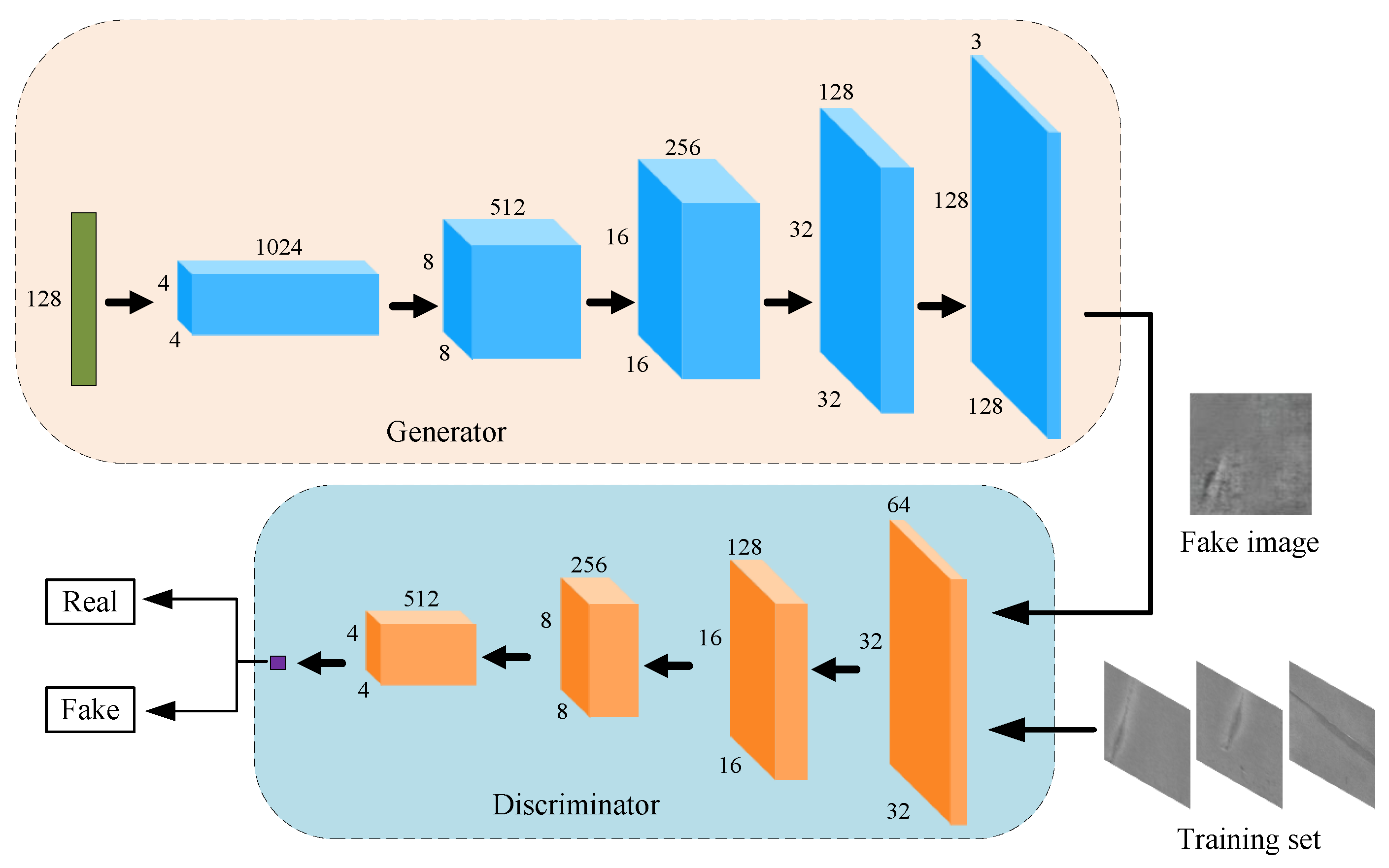
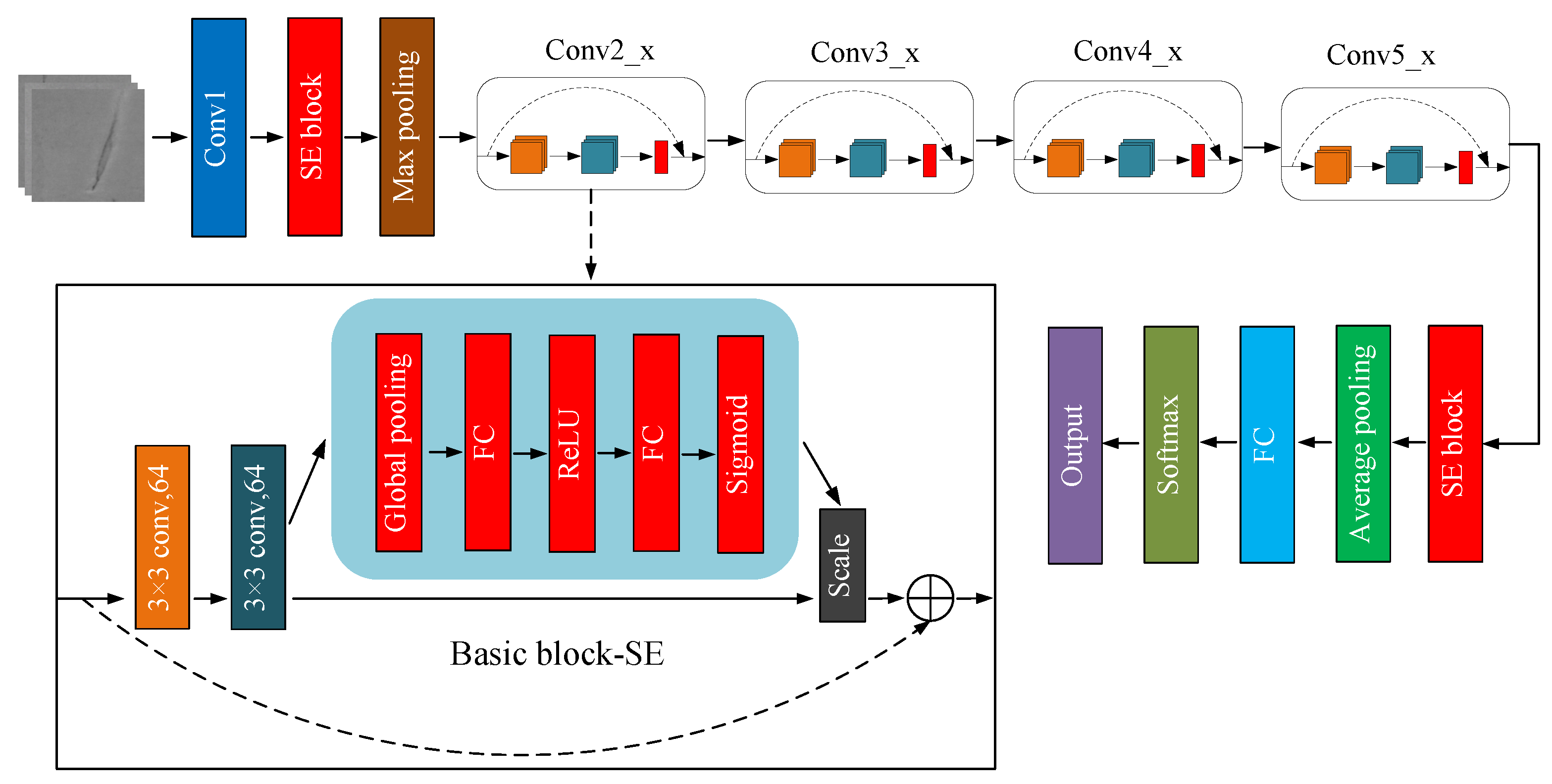

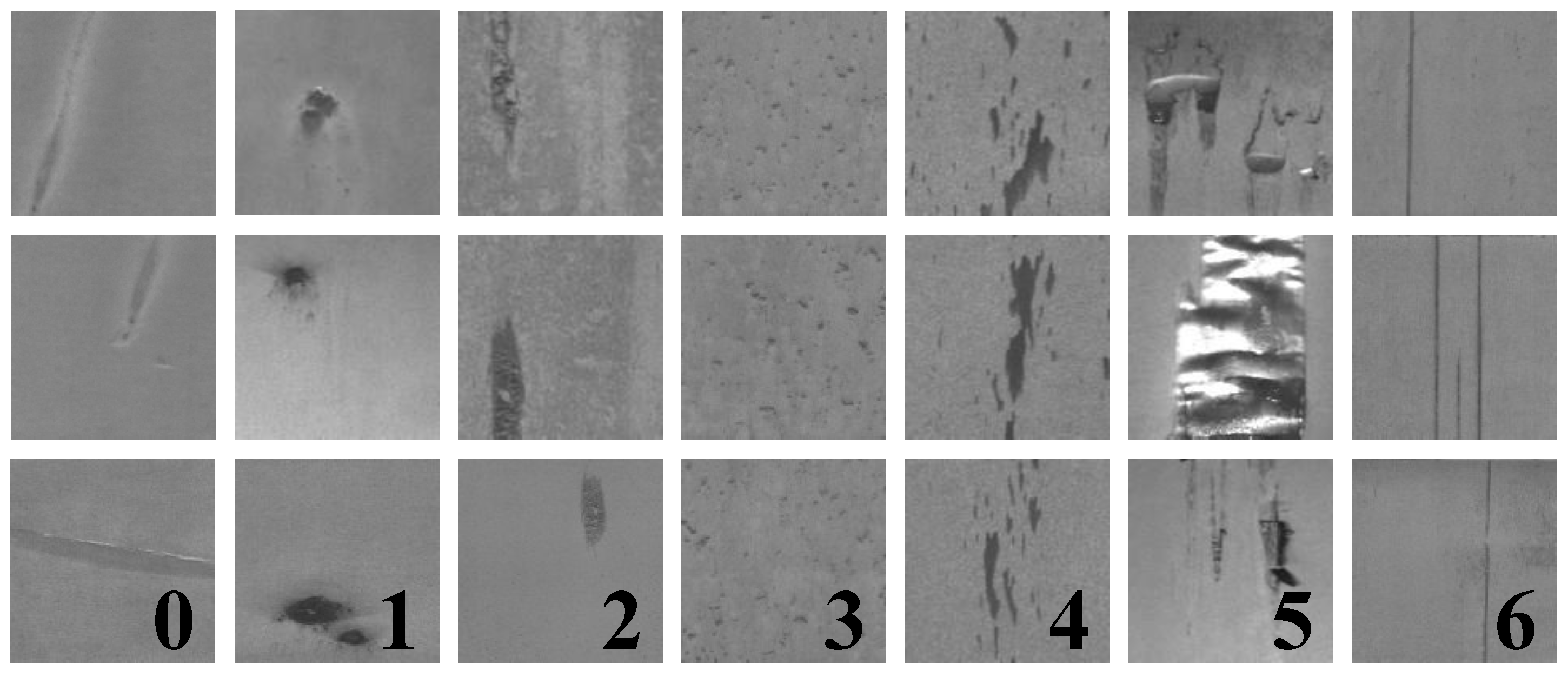
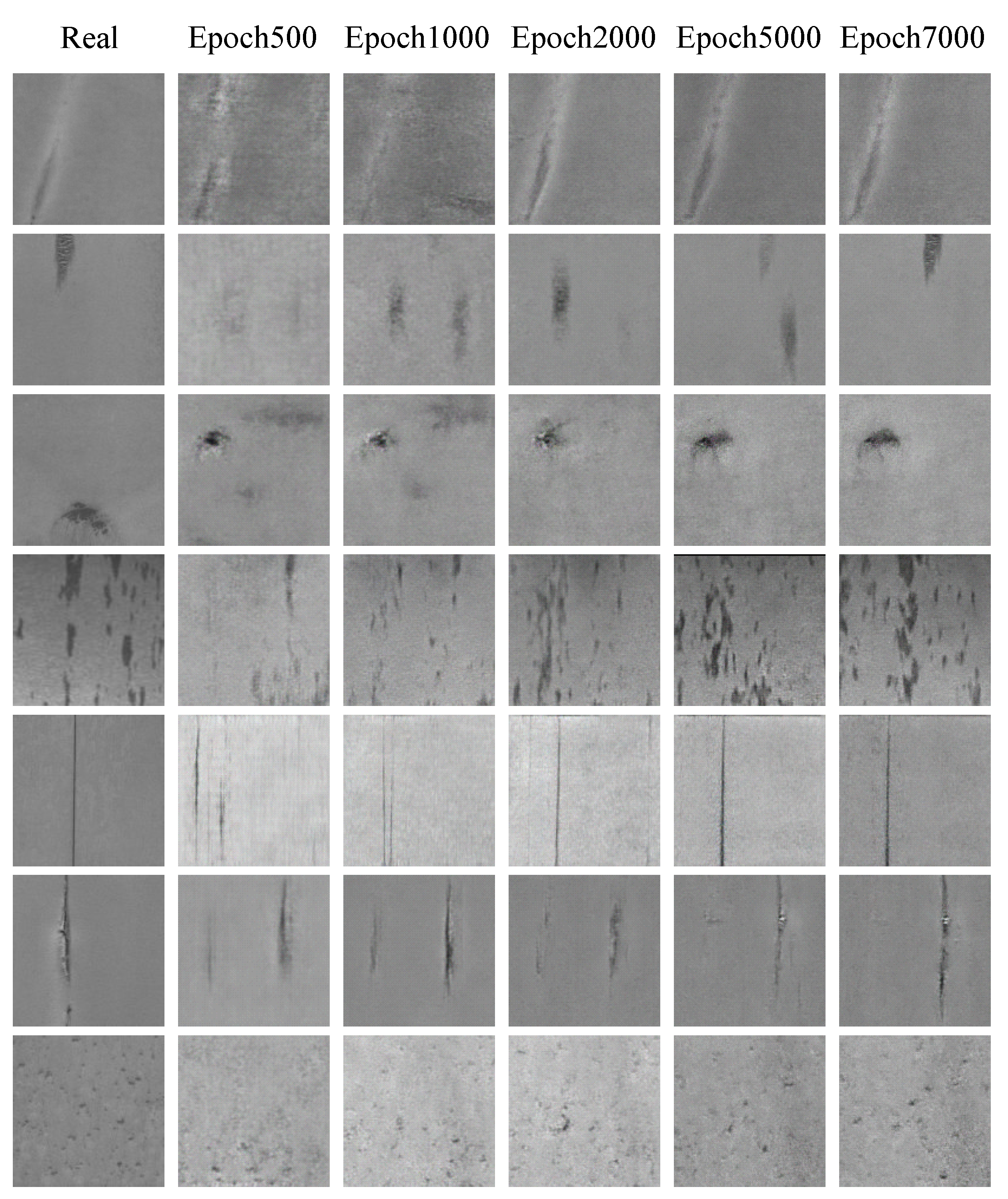
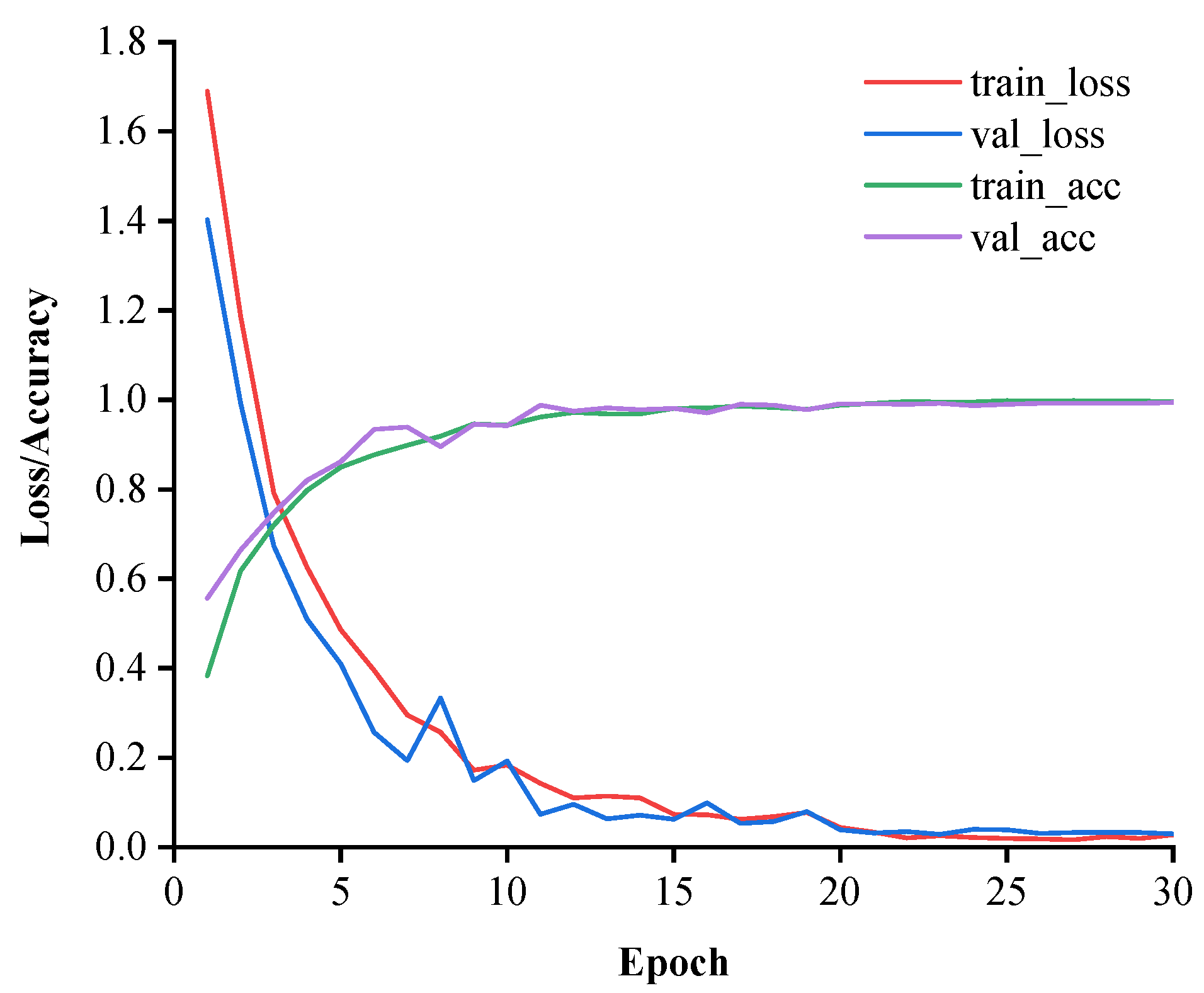
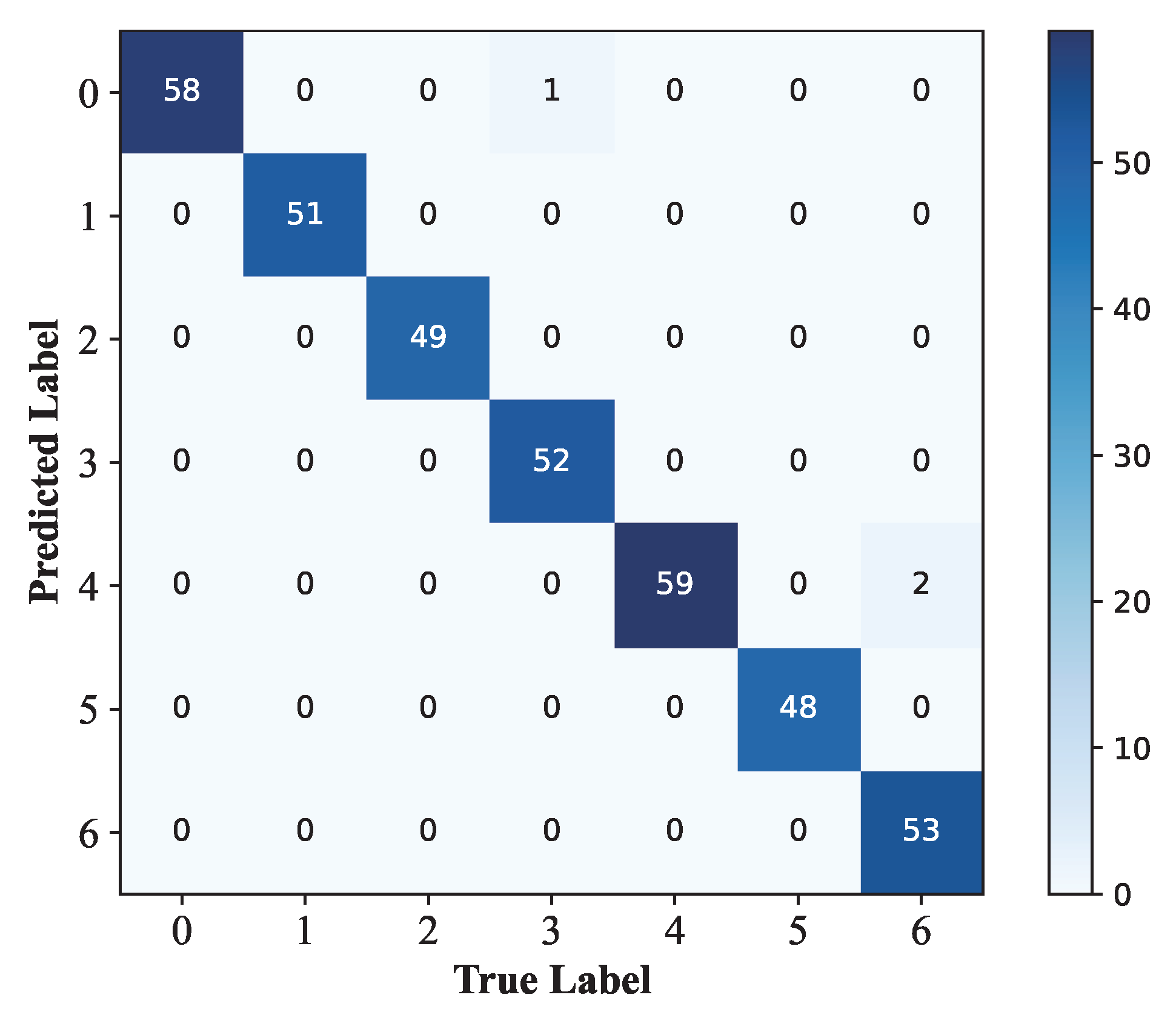
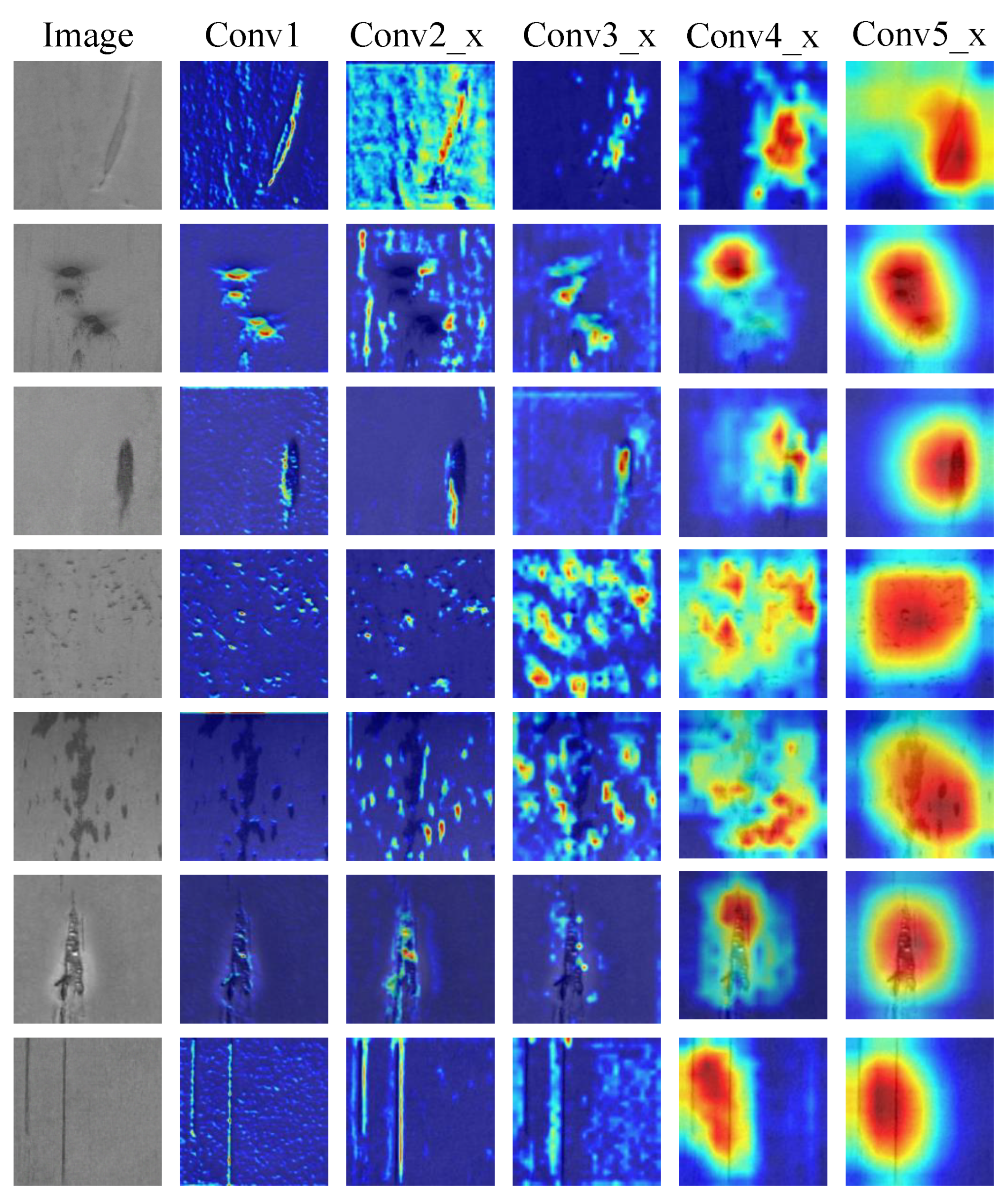
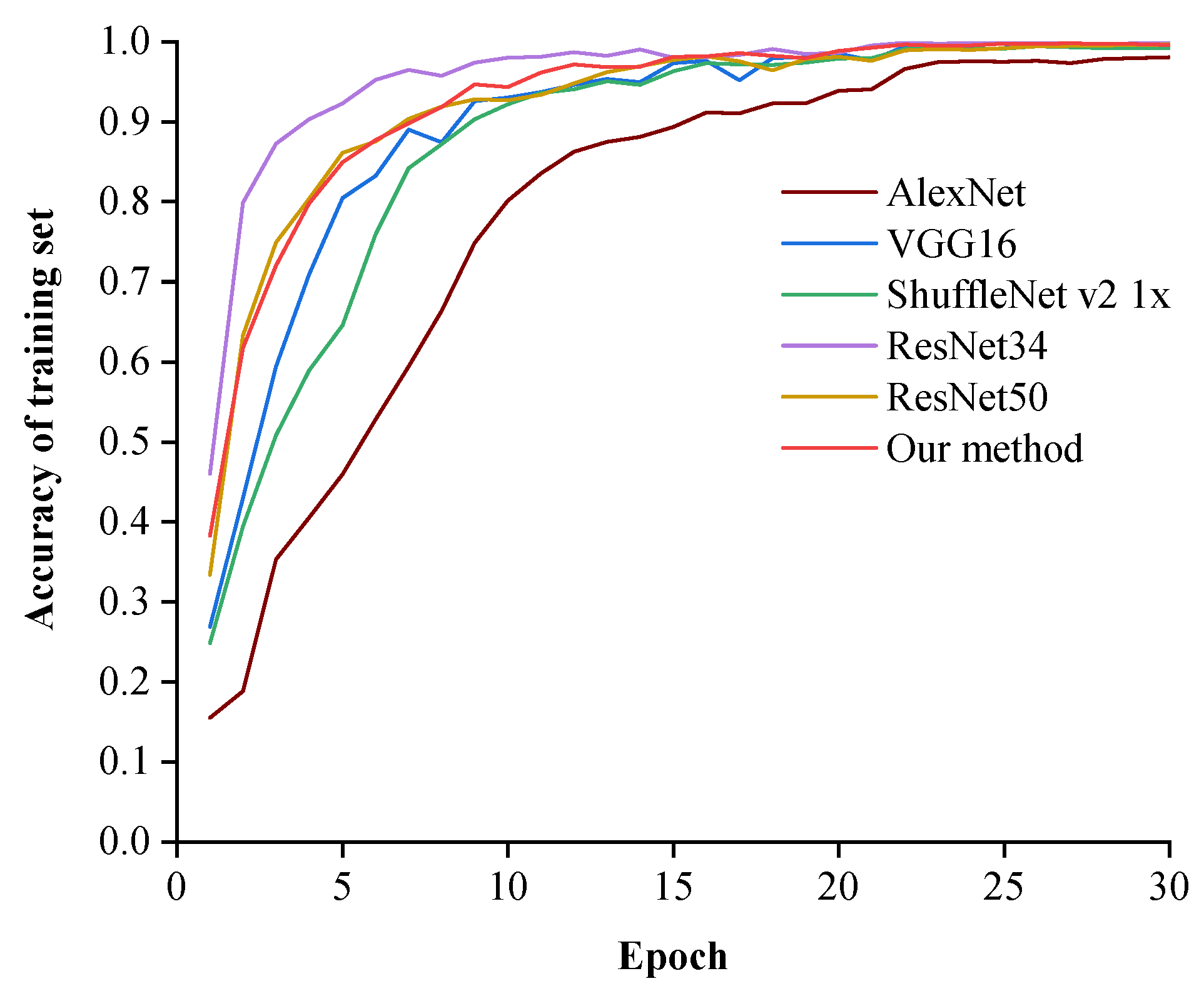
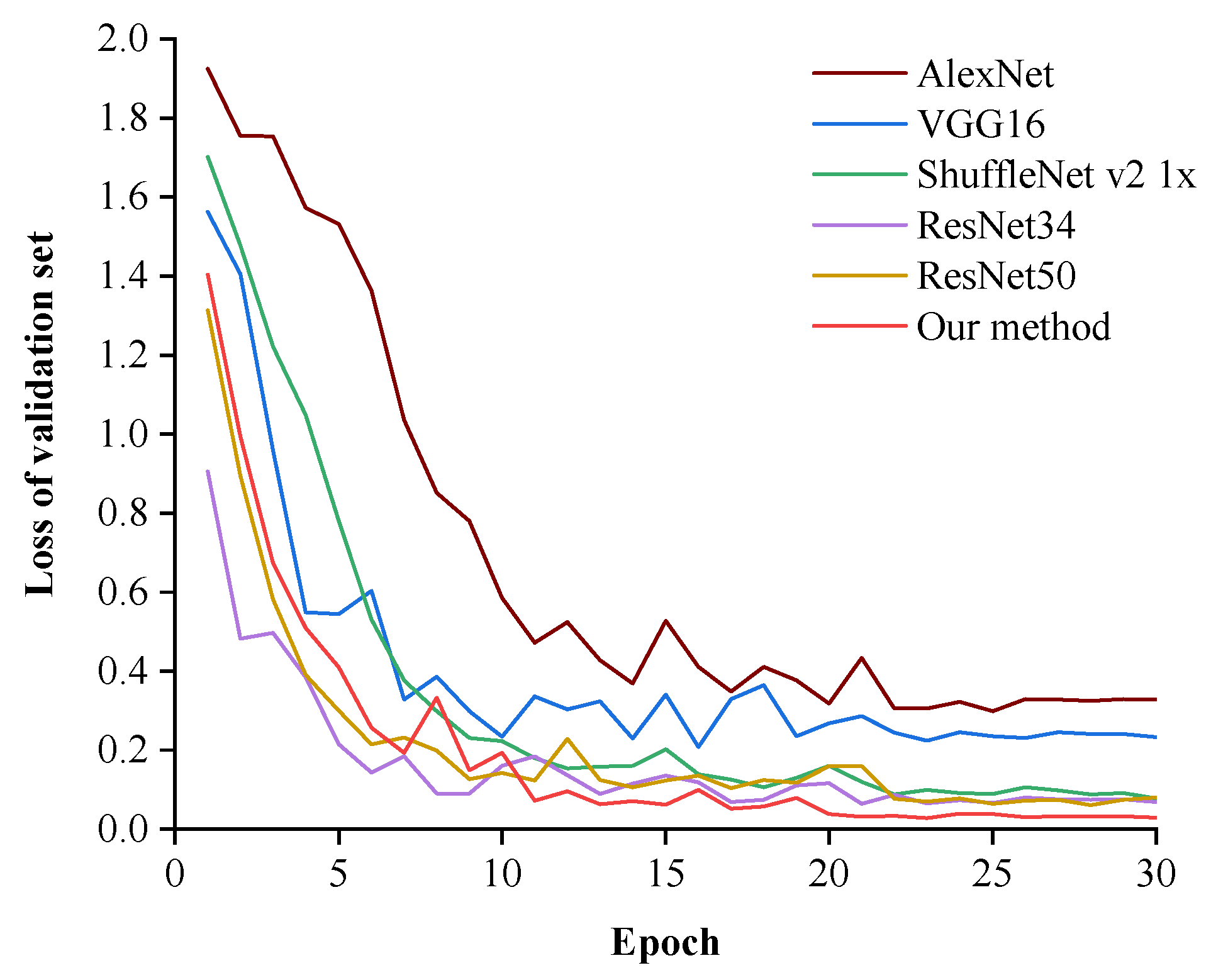
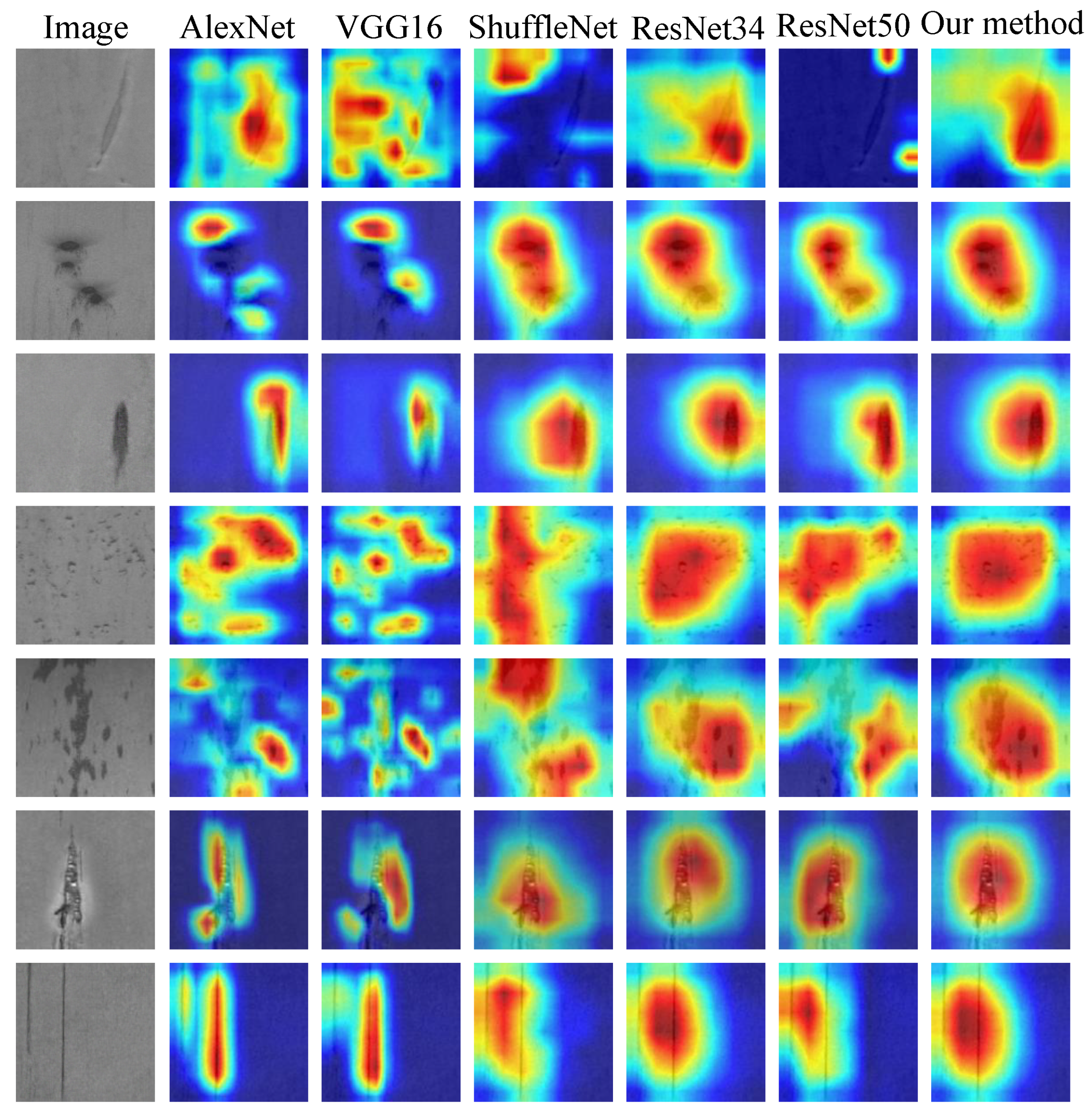
| Category | 0 | 1 | 2 | 3 | 4 | 5 | 6 |
|---|---|---|---|---|---|---|---|
| Original | 203 | 122 | 63 | 203 | 397 | 238 | 134 |
| Enhanced | 589 | 517 | 498 | 530 | 595 | 488 | 556 |
| Accuracy (%) | Macro-Precision (%) | Macro-Recall (%) | Macro-F1 (%) |
|---|---|---|---|
| 99.20 | 99.29 | 99.21 | 99.24 |
| Model | Accuracy (%) | Macro-Precision (%) | Macro-Recall (%) | Macro-F1 (%) |
|---|---|---|---|---|
| AlexNet | 92.49 | 92.82 | 92.15 | 92.19 |
| VGG16 | 94.64 | 95.06 | 94.30 | 94.45 |
| ShuffleNet v2 1× | 97.32 | 97.38 | 97.26 | 97.30 |
| ResNet34 | 98.66 | 98.68 | 98.59 | 98.61 |
| ResNet50 | 97.86 | 97.88 | 97.72 | 97.77 |
| Our method | 99.20 | 99.29 | 99.21 | 99.24 |
Publisher’s Note: MDPI stays neutral with regard to jurisdictional claims in published maps and institutional affiliations. |
© 2022 by the authors. Licensee MDPI, Basel, Switzerland. This article is an open access article distributed under the terms and conditions of the Creative Commons Attribution (CC BY) license (https://creativecommons.org/licenses/by/4.0/).
Share and Cite
Hao, Z.; Li, Z.; Ren, F.; Lv, S.; Ni, H. Strip Steel Surface Defects Classification Based on Generative Adversarial Network and Attention Mechanism. Metals 2022, 12, 311. https://doi.org/10.3390/met12020311
Hao Z, Li Z, Ren F, Lv S, Ni H. Strip Steel Surface Defects Classification Based on Generative Adversarial Network and Attention Mechanism. Metals. 2022; 12(2):311. https://doi.org/10.3390/met12020311
Chicago/Turabian StyleHao, Zhuangzhuang, Zhiyang Li, Fuji Ren, Shuaishuai Lv, and Hongjun Ni. 2022. "Strip Steel Surface Defects Classification Based on Generative Adversarial Network and Attention Mechanism" Metals 12, no. 2: 311. https://doi.org/10.3390/met12020311
APA StyleHao, Z., Li, Z., Ren, F., Lv, S., & Ni, H. (2022). Strip Steel Surface Defects Classification Based on Generative Adversarial Network and Attention Mechanism. Metals, 12(2), 311. https://doi.org/10.3390/met12020311







